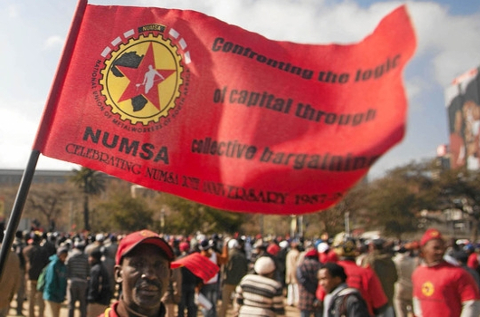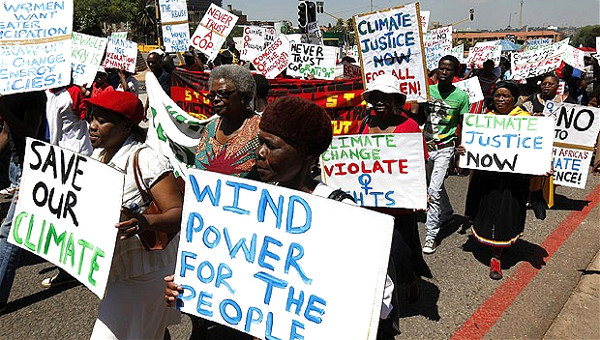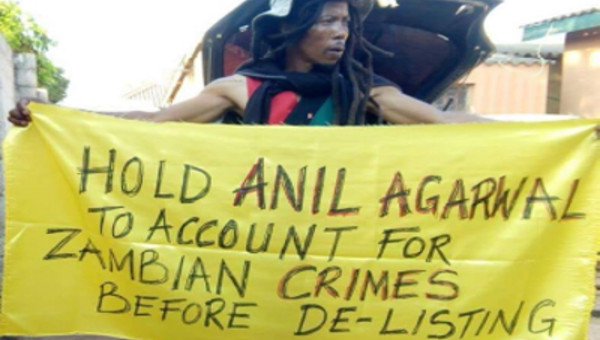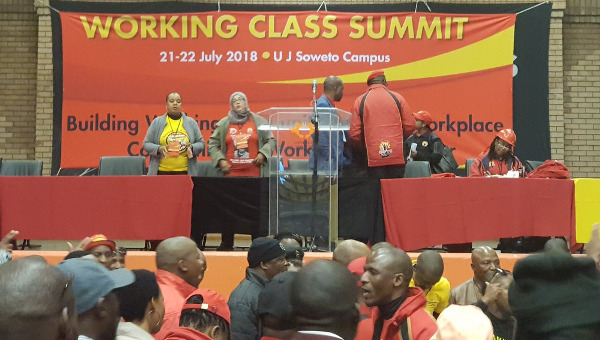South African Metalworkers Change Course
Watching the events to commemorate Nelson Mandela’s death was to watch history being re-written. Mandela the terrorist was forgotten. International leaders of every stripe struggled to bask in his aura of courage and forgiveness as if they’d always been at his side. The jagged and tumultuous and contested path of the internal forces to end apartheid was not part of the narrative nor was the multi-facetted international anti-apartheid movement visible in the story. Yet the profound disappointments with what the liberation movement in power has delivered could not be written out of the script. Boos interrupted the peons of praise for Mandela each time President Jacob Zuma rose to speak. The spontaneous protest against Zuma’s most recent scandal, squandering $20-million of state funds to build a palatial home at Inkandla, could not be kept hidden. Watching president-in-waiting Cyril Ramaphosa, ex-mineworkers’ leader turned powerful business tycoon, maneuvering adroitly at Zuma’s side, filled me with foreboding for the years ahead.

I had been in Johannesburg shortly after the massacre at the Lonmin platinum mine in Marikana in 2012 where police opened fire on striking mineworkers, killing 34, some shot in the back, and wounding many others. The inquiry shortly thereafter included emails between Ramaphosa, now a Lonmin board member and shareholder, denying the strike was a labour action. In the emails he dismissed the mineworkers as hoodlums and urged Lonmin managers to call in the full powers of the law to force an end the strike. The greatest concern voiced by Ramaphosa and other ANC leaders was that the labour unrest might diminish investor confidence.
In the midst of this bleak scenario came news that the NUMSA Special Congress held December 16-20 had resulted in a remarkable repositioning of South Africa’s 338,000 member National Union of Metalworkers. I had read the resolutions with excitement from Canada with the call for a united front against neoliberalism and the exploration of the establishment of a movement toward socialism. I had hoped to get together with old friends from NUMSA for a coffee as I passed through Johannesburg in late January. “No time for a coffee” was the reply, but instead they invited me to join them at the political school they were holding with 170 stewards from their nine regions. The week-long school was to culminate in a “Resistance Expo” on the Saturday to which they had invited community groups divided into 13 different sectors, from land and food sovereignty to health services, LGBTI to solidarity economy, immigrants to the unemployed. These groups were invited to share their experiences and strategies of fighting against neoliberalism. I got to sit in on the last four days of intense debates and presentations and moments of encounter as NUMSA Education Department worked to equip NUMSA leaders at the base to take on the resolutions more fully and explore how to implement them at the local level.
NUMSA Special Congress December 2013:
Drawing Lessons from Marikana
Marikana marked a turning point and NUMSA pondered long and hard the lessons of Marikana as it prepared its Special Congress, especially the mass exodus from NUMSA’s counterpart private sector giant in COSATU, the National Union of Mineworkers (NUM). In May 2013, NUM reported publicly a loss of 40,000 or 14 per cent of its membership, with further losses since. Some NUM members fled to AMCU, a newer rival union in the mining sector created by former NUM leaders. Some Marikana miners remained in independent worker committees. Some came knocking at NUMSA’s door, leading to accusations that NUMSA was poaching. The NUMSA reply – we are not dealing with rhinos here – did little to quell anxieties. The NUMSA Congress included a discussion on this question. The Congress documents stated that NUMSA was not seeking out members from other unions but found itself faced with workers who, on their own accord, were seeking out NUMSA. It was difficult to turn away workers who voluntarily wanted to join NUMSA, particularly when turning them away meant sending them to non-COSATU unions.
Christine Olivier, NUMSA 2nd Deputy President and Karl Cloete, Deputy General Secretary, gave a detailed briefing on the six issues of the NUMSA Special Congress to the civil society delegates who participated in the Resistance Expo. Issue one was the tri-partite Alliance binding the trade unions, through COSATU, to the African National Congress (ANC) and the South African Communist Party (SACP). NUMSA called on COSATU to break away from the Alliance, organize a united front and explore the establishment of a movement for socialism. Issue two was the ANC and its decisions to adopt policies of neoliberalism in South Africa, along with its widespread corruption and misappropriation of state funds. The Congress called for Zuma’s resignation, the housing scandal being only one of the many reasons to do so. Issue three was the Challenges Facing COSATU. Amidst rampant speculation that NUMSA wanted to leave COSATU and launch another central, the NUMSA Congress called for a COSATU that was “independent, democratic, worker-controlled, militant, anti-imperialist and campaigning.” These were the characteristics of the COSATU that had been such a key player in the struggle to end apartheid but all these characteristics have been lost in recent years in the accommodation to Alliance dictates.
Issue four was the 2014 national elections and NUMSA’s decision not to support any political party. This issue was the most sharply debated and the one that has already had some push-back from the base. The compromise resolutions that were hammered out will mean that NUMSA activists will need the wisdom of Solomon to put them into practice. NUMSA will not endorse any political party in 2014. NUMSA’s members will have the right to vote for the party of their choice, but NUMSA as an organization will provide no financial or organizational support for the ANC during the election campaign.
Clothing may not make the (wo)man but virtually every activist at the NUMSA school sported an Alliance t-shirt, cap or jacket. Many NUMSA leaders in the regions are also elected office-bearers of ANC and SACP locally. Indeed in one of the break-away discussions on Sunday morning, a NUMSA leader from Mpumalanga apologized for taking an urgent call. ANC members from his area were on the line saying they were doing house to house electoral canvassing and where was he, the ANC chairperson in the area. The NUMSA members were urged to treat the break with the Alliance with great care, fully aware that there are committed activists in the ranks of the ANC who are as troubled as the NUMSA activists are about current directions and leadership in the Alliance.
Clearly, working through the break with the Alliance family, individually and organizationally, will be a huge challenge. The resolution also called for the establishment of a united front and to “explore the establishment of a movement for socialism.” The Congress resolutions harkened back to the challenge Madiba had given to COSATU at its Special National Congress in 1993.
“You must be vigilant! How many times has a labour movement supported a liberation movement only to find itself betrayed on the day of liberation? There are many examples of this in Africa. If the ANC does not deliver the goods, you must do to it what you did to the apartheid regime.”
While the first four issues, with the call to break away from the Alliance, the call for Zuma’s resignation, the call for COSATU to become independent and militant again, the decision not to give endorsement, funding or organizational support to the ANC in the forthcoming elections and the call for a united front and a movement for socialism garnered most media attention, the NUMSA services charter may in the end have equally far-reaching consequences. Cloete spelled out a little of NUMSA’s analysis of what lessons to draw from Marikana and the NUM exodus. The main lesson was that allowing differences to be established between the elected shop stewards and members is a sure fire method of killing a union. One of the post-Marikana revelations was that the mining houses had been topping up the salaries of NUM stewards in recent years. As the Congress resolution on Marikana stated:
“What we wanted to do at this Congress was to look closer to home and ask
what Marikana means for trade unions and the entire labour movement. We wanted to do this introspection because as NUMSA, we sincerely believe that as a union we are not immune from the mass desertion by members of a traditional union to a new union.”
As an example, NUMSA leaders scrutinized one of the anomalies in their own organization where they had negotiated an agreement with Mercedes-Benz that full-time shop stewards had the right to a new Mercedes-Benz annually. The Congress committed itself to diminishing the distance between elected stewards and ordinary members and going back to basics on providing high quality services to members.
Issue six was also less of a media sensation but, if accomplished, likely to be more far-reaching. The Congress committed NUMSA to socio-economic strikes, a vision of wall to wall working-class actions on all the issues that affect working people. Cloete’s earlier presentation to the stewards themselves revealed how NUMSA sees these actions developing. The Congress called for NUMSA to be active in all struggles against neoliberalism and not just those immediately affecting workers. He portrayed it as a new freedom to participate in working-class struggles, reference to life within the Alliance where important resistance struggles were deemed counter-revolutionary or subversive by the Alliance.
Resistance Expo – Sharing Strategies Against Neoliberalism
The idea of a Resistance Expo in which a range of community organizations would come to the political school and share their stories and strategies of resistance to neoliberalism emerged at a planning meeting on January 7. By January 31, it had become a reality as more than 100 community activists flooded into the Johannesburg airport hotel where the school was being held, representing 13 different sectors. In the days after the Congress, NUMSA had been deluged with hundreds of mails from well-wishers endorsing the new directions and wanting to hook up. Many of them collaborated with the NUMSA Education Department in organizing the Resistance Expo. The ground rules were no parties, no NGOs, no academics and no independent unions except those working in NUMSA’s sectors.
What better way to concretize the path toward a united front against neoliberalism than to start walking it. Through the Expo, NUMSA succeeded in orchestrating initial dialogues with potential fellow-travellers in the safe context of the political school. The Expo served to free NUMSA activists from the old stereotypes of who the community activists were, a necessary antidote after years of Alliance vilification of them. The Expo also helped convince community activists that the NUMSA repositioning was for real.
There were careful briefings for both sides before the Saturday in which the NUMSA activists, divided into groups of 10, engaged with each of the community groups. In some cases the community groups had met previously and had a presentation to break the ice. In other cases, it was a more unstructured conversation. As mentioned above, NUMSA national leaders gave a briefing to all of the community activists as they gathered at the hotel on Friday. They reiterated that a United Front could never be formed from top-down initiatives but only through sharing common struggles. Cloete admitted openly to the irony that he, former chairperson of the SACP in Western Cape province, should be the one now encouraging this path so distant from what the Alliance modus operandi had been.
For the NUMSA activists, the preparation was three-fold with group study of classic Marxist texts on experiences in Europe of building a united front to opportunities to hear from activists involved in more recent experiences of united fronts in South Africa. These ranged from the United Democratic Front (UDF) that was so important in bringing down the apartheid regime in the 1980s to the Anti-Privatization Forum in the 1990s.
The study of the classic texts from European experiences of the last century on Thursday afternoon, at the end of a long day, seemed a little problematic. Their stress on leadership from the “most advanced elements” and “most combative forces” was curiously at odds with the many admonitions from NUMSA leaders over the four days that NUMSA’s role in the united front was also one of learning from others, of together creating something new from below, of recognizing that NUMSA did not have all the answers. The stewards, however, battled end of the afternoon fatigue to tackle the texts gamely.
The preparation through looking at past experiences in South Africa was carried out by inviting trusted activists to reflect on the experiences. I had to miss the UDF session in order to participate in the community briefing but the presentations from the Anti-Privatization Forum (APF), regularly vilified by the Alliance, were fascinating and relevant. John Apollis now with a new union formation, GIWUSA, gave the history of the Anti-Privatization Forum. This earlier experience of a united front against neoliberalism brought together 33 community groups; COSATU was part of the Forum at the beginning but later pulled out. He reflected on the tensions between different methods of struggle. In 1994, the year of South Africa’s first elections, ten million people had cuts in electricity and water services. In 2001, 75 per cent of those living in Soweto had their power disconnected as part of the new policy of fees for services. Reconnecting poor people to public services was one of the methods of direct action that APF adopted, with “struggle plumbers” and “struggle electricians” re-connecting water and electricity lines to township houses.
For the poor and the unemployed, a strike was not an available method of struggle. Direct action, blockades and tire-burning were adopted. The survival issues of housing, water and electricity resulted in a state of permanent mobilization and crisis management that was very difficult to sustain. It was also very different from the methods of struggle available to the unions, where moments of high mobilization could be organized during bargaining, followed by periods of relative calm. Some of the discussions about clashes between different organizational cultures and forms of struggle made me think back to debates and tensions in united front formations here in Canada such as the Action Canada Network or the Days of Action in Ontario against the neoliberal agenda of Mike Harris.
Prishani Naidoo, another activist now teaching at Wits University, claimed the APF as an important formative experience in her life as a militant. She also talked about the clash of cultures. The Alliance quickly labeled the APF as counter-revolutionary. Yet many members brought the Alliance traditions with them into the Forum. There were seemingly endless debates about what kind of leadership should be adopted, what kind of discipline members should be under.
TINA (There is No Alternative), was the stance maintained strongly by government, disdaining any suggestion of possible alternatives to the neoliberal model. TATA (There are Thousands of Alternatives) was the reply from the APF, with the heady freedom to declare that Alliance leaders were wrong and to insist that only in the trenches, making and shaping together, would the thousands of alternatives of TATA emerge. The APF openly questioned whether the organized working-class at the centre of capitalist production had the inherent task of spear-heading the revolution. The Forum dared to say openly, “the ANC is crippling us.”
Prishani felt that the reconceptualization of a new political subject, a new relationship between community and labour, never really got played out. Those trying to produce something new, leaving behind pre-conceptions, were blocked by others with too many fixed ideas. Her challenge to the NUMSA stewards was to be open to uncertainties, trusting that answers would come from saying “we don’t know,” that ways would open through tackling problems together. She left the stewards with words from the Zapatistas in Mexico: “Walking, we ask questions.”
The practical orientations for the morning of engagement between union stewards and community activists, while tongue in cheek, gave a sense of the challenges ahead. “Don’t tell the community groups they have no leaders. They will be insulted – and besides, it’s not true!” If you are in the group that engages in the women and gender conversation, please do not ask for phone numbers.” “If your group talks with the LGBTI sector, don’t say to anybody ‘I can make you straight.’”
From the Bottom Up and to the Left
NUMSA Education Director Dinga Sikwebu, himself a seasoned activist, inserted notes of caution at various points through the school, reminding the activists that NUMSA is entering a new terrain, with unfamiliar territory, in which NUMSA itself will have a lot to learn. “The idea that NUMSA knows everything and has all the answers is just something we’ll have to deal with. NUMSA is well-known for its resoluteness. The danger we have to avoid is organizational chauvinism and arrogance.”
The high energy mood of the stewards reflected this resoluteness. Sessions began and ended with songs in four part harmony, songs known by all from the anti-apartheid years and from bargaining campaigns but made new with words adapted to the current struggles. “Don’t cry, my child. We are fighting for our rights, our rights that were stolen from us” was one theme. Another had the refrain “NUMSA is moving very quickly” and verses dealing with those reluctant to leave ANC and SACP. Another song comes out of bargaining campaigns and has a repeated refrain of “We promise that one day we’ll deal with you.” In bargaining, this meant dealing with the employers. The adaptation to today’s struggles refers to dealing with the ANC and SACP.
NUMSA has indeed embarked resolutely on a bold programme of action since the December Conference. The political school and Resistance Expo only a month later created a tool for NUMSA regional leaders to take on the Congress decisions as their own and be more ready to deal with the inevitable confusions and push-back as the resolutions are put into practice. Even though the spirit of unity that prevailed during the Congress was extremely strong, the challenges ahead are enormous.
“What has happened in the past week on community issues of water or health or police violence must also become part of the NUMSA agenda.”
The school provided a space to try on the new level of engagement with community groups that the resolutions have mandated. At one point all stewards who had had some kind of resistance struggle take place in their communities over the past year were asked to stand up. About 70 of the 171 stewards present stood up. They mentioned struggles over issues such as housing, land, health care. Then those stewards standing were asked to stay on their feet if NUMSA had joined the community members in those struggles. Only eight remained standing. The discussion that followed probed some of the reasons for union members to feel distant from community initiatives and concluded that in order to build a united front against neoliberalism, things had to change. The agenda items for the regular NUMSA stewards councils could no longer be simply members’ day to day issues in the workplace. “What has happened in the past week on community issues of water or health or police violence must also become part of the NUMSA agenda.”
A united front can only be built from below, in the trenches. This was said at many moments and in many different ways. The first post-Congress political school helped the regional leaders begin to think practically about how to build a united front in each region. Two more political schools are planned for 2014, one in April and one in July.
NUMSA is also embarking on Consultative Conferences in each of NUMSA’s nine regions. The conferences will be open to any person or organizations on the left. These will be organized as a matter of urgency and will culminate in a national consultative conference. The NUMSA Congress also mandated an ambitious programme of rolling socio-economic strikes. The first of these was scheduled to take place on February 26 with a mass march focused on a new proposal for an Employment Tax Incentive targeting young workers. This policy was characterized as an election ploy, side-stepping the chronic structural unemployment for which South Africa is notorious with the official unemployment rate stuck at 20 per cent.
The government stalled in the negotiations as they did not want the strike to take place on February 26, the day the Minister of Finance was to deliver his budget. With the subsequent deadlock, NUMSA was outside the required 14-day notice required for a legally protected strike. NUMSA therefore moved the date to March 19 and NUMSA activists are busy now with their newly found allies in mobilizing for this date.
The rolling mass action NUMSA hopes to carry out will unfold in six phases. Target 2 is increases in import tariffs, followed in phase 3 by nationalization of the Reserve Bank, exchange controls and an end to inflation targeting. Phase 4 includes de-commercialization of state enterprises and re-nationalization of SASOL and Arcelor Mittal South Africa. Phase 5 will focus on labour market issues and low-wage strategies and Phase 6 will focus on nationalization of the mines.
Exploring a Movement for Socialism
The item in the programme of action that has riveted international attention is the Congress mandate to “explore the establishment of a Movement for Socialism.” NUMSA hopes to carry out the formation of a united front while, at the same time, exploring the establishment of a movement for socialism.” Both in the Congress documents and in various presentations at the school, it was underscored that NUMSA will carry out a serious study of the formation of working-class parties and experiences of building socialism, not only in Africa but also drawing from the experiences of such countries as Brazil, Venezuela, Bolivia and Greece. In July 2014 NUMSA is planning to host an International Conference on Socialism that will lead to deeper discussion of what we understand socialism to be at this moment in history.
The NUMSA leaders are very aware that they have embarked on a bold new path, creating enormous expectations within South Africa and beyond. They have begun with a mixture of daring and solid organizational work within their own rank and file leadership. The organization of a Resistance Expo, reaching out to fellow-travellers who are also “walking and asking questions” was truly inspired. While maintaining its allegiance to Marxist-Leninist traditions, NUMSA took a giant step away from the comfort of theoretical assertions. Through the Expo, it encouraged its stewards to step out of their organizational comfort level and into the rough and tumble of contemporary issues in South Africa, engaging with community activists currently working on multiple fronts of struggle. These political schools for stewards are a key part of the NUMSA strategy, challenging their stewards to take on new roles and to ask new questions, using the schools to “create the yeast to make the bread rise.”
The final session captured the spirit of the school in these words.
“The idea is not that NUMSA can do everything. NUMSA alone cannot challenge the status quo. How can we work together, recognizing eachother’s strengths and weaknesses, to solve the problems of the poor and working-class in this country? We have called for a united front but don’t come asking for a launch date. We see it as a mechanism, a way to join other organizations in action, in the trenches, with the hope that in working together we can create something. We need to unite with those wanting a better South Africa, a socialist South Africa.” •





